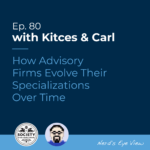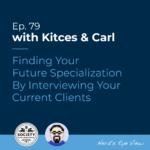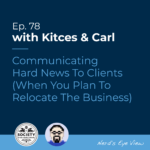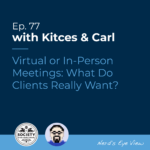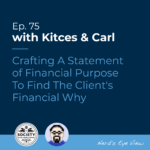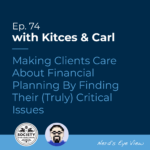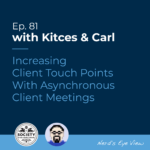
Conventionally, meeting with a financial advisor meant meeting in-person, usually at the advisor’s office. With today’s technological advances, though, compounded by changes in social dynamics brought forth by the pandemic, meeting virtually (or mostly virtually) has become increasingly normalized, which has made it easier than ever before to accommodate more meeting time into busy schedules. But while the capacity to schedule more meetings has also given advisors the opportunity to spend time engaging more deeply with their clients, it has also meant that they may have less time to accommodate touch points with a broader range of their entire client base. One potential solution that can help advisors address this time crunch is to consider using asynchronous meeting strategies to help free up more of their time.
In our 81st episode of Kitces & Carl, Michael Kitces and client communication expert Carl Richards discuss what it means to meet asynchronously, when it is appropriate to utilize, and how advisors can use asynchronous meetings to increase touch points for clients.
As a starting point, it’s important to recognize that while advisors may still need to devote more time to certain clients with complex financial circumstances who simply require more attention, newer clients often need frequent meetings only initially in the relationship. This is because in-person meetings early on provide a space for dialogue that lets new clients build trust and rapport with their advisor in the first place. But, once a certain level of trust is established, many clients often feel that frequent meetings are no longer necessary and may actually request fewer routine meetings; in fact, they may prefer communicating only on an as-needed basis to ensure that they stay on track with their financial plan.
Furthermore, while there may still be times when synchronous meetings are the most appropriate method of contact, they are not the only way to maintain the right level of touch points with a client. For instance, asynchronous meetings can sometimes be more suitable for situations between in-person meetings or video chat sessions, when a real-time connection is not entirely necessary (e.g., answering a question about how to find information on a platform). Using asynchronous meetings to quickly address lower-priority issues helps free up time for the advisor, as it generally takes less time to record a quick, informal video response than it does to write an email or to meet in person. Asynchronous meetings also don’t require the need to schedule or prepare for an in-person meeting, which can be time-consuming and simply unnecessary (especially when a 5-minute video clip can suffice).
Ultimately, the key point is that asynchronous meetings are not meant to replace all meetings; instead, they can be used to communicate more easily and quickly with clients when an actual meeting isn’t really necessary. While there will always be pressure to maintain a certain level of touch points with clients, advisors can rely on advances in technology that have made it easier and much more affordable for them to use asynchronous strategies (e.g., recording a quick video response) to respond to their clients’ needs without having to schedule meetings. And taking less time to schedule meetings means more time for the advisor to create more touch points and provide a better client experience. Because the more touch points an advisor can have with clients, the more opportunities there are to deepen and maintain long-term relationships with those clients!

